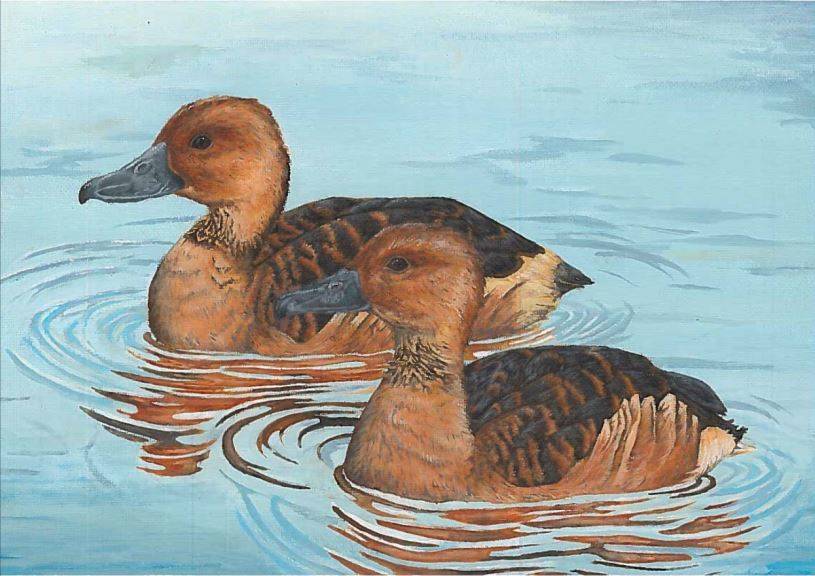When Veronica Salter first looked at paintings from the annual Duck Stamp competition, she was a little overwhelmed at the skill apparent in the artwork. Salter, who was a sophomore at Thunder Mountain High School when she first thought about entering the contest, had enjoyed drawing from a young age but this contest was daunting.
“I looked at all the different paintings that people have done over time,” Salter said, “and I was kind of intimidated because all of the duck stamp paintings I’ve seen in general are just amazing and really detailed and well done, so I wasn’t sure about it at all.”
Now, Salter’s position has switched. Her work will stand as a daunting example for younger artists, as she won the Alaska Junior Duck Stamp competition and finished fifth in the national competition. Thunder Mountain art teacher Angela Imboden said that the state’s Duck Stamp coordinator told her it’s the highest finish she can remember for an Alaska student.
Artists who compete in the annual Duck Stamp competition are vying for their artwork to be on the Duck Stamp for that year. Waterfowl hunters ages 16 and above are required to purchase Duck Stamps, which serve as hunting licenses and raise money for conservation efforts.
The Junior Duck Stamp competition determines the design for the Junior Duck Stamp, which is a collector’s item available for $5 that raises money for environmental education activities. More than 28,000 students participated in this year’s contest from all 50 states, as well as the District of Columbia, Puerto Rico and the U.S. Virgin Islands.
Those looking to enter in the competition peruse a list of species of ducks eligible to be drawn. Salter entered the 2016 competition and performed decently well in the state competition, but took it much more seriously this year. She examined pictures of ducks much more exhaustively and was especially drawn to the Fulvous whistling duck.
“I always look at the head shape of ducks and kind of how they look at things,” Salter said. “I don’t know how to describe it, the way that their eyes and head are kind of in line. I liked the composition that this duck had, the Fulvous whistling duck. Its feathers, I liked the colors and shapes and the patterns on its back, a tiger-esque kind of look.”
Salter came to the art classroom on weekends. She came in during parent-teacher conferences. She’s not sure how many hours she spent on her painting, but the number was much higher than it was in 2016.
She’s more interested in drawing than she is in painting, but with more practice, she became more confident in her abilities. With more confidence, she enjoyed the process more and spent more hours on the painting.
Imboden said Salter has natural talent, being able to sit down and start drawing without much preparation at all, and that the mix of that talent and an increased work ethic yielded a product that was the best in the state.
“I knew it would win first place,” Imboden said, “and I was just thinking, ‘This definitely has potential for a state winner for sure and it’s got high potential for the nationals.’”
Along with the artwork, entrants into the contest must come up with a conservation statement, which is just one sentence that sums up what the artist has learned in the process or what is important about protecting the environment. Salter’s statement, “We conserve not only to protect what has been in the past, but to benefit what will be in the future,” was also named the best in the state.
She was a little surprised at that victory, too, saying that those in Alaska are naturally drawn to environmental issues and that the competition was stiff.
“Growing up in Alaska, conservation and environmental studies is something that you grow up hearing about and knowing about,” Salter said. “There are a lot of opportunities to get involved in that in Alaska and Juneau as well.”
Salter found out about her state victory late one night in early April and was too surprised to say much of anything to the Department of Fish &Wildlife spokesperson who called her. Salter wasn’t the first one to find out, as Imboden and Salter’s parents already knew. After the call, Salter’s mother jokingly asked who the call was from before they celebrated the victory.
Salter was then out of town the weekend of the selection of the national honors, at an arts festival in Petersburg. She wasn’t worried or stressed about the national competition, as winning the state contest was exciting enough. When she opened an email this Monday that included the list of national winners, she was once again surprised.
“I don’t think there’s any physical prizes that go along with that,” Salter said of her fifth-place finish nationally, “but the placing was more than enough for me. That was really awesome.”
• Contact reporter Alex McCarthy at alex.mccarthy@juneauempire.com or 523-2271

